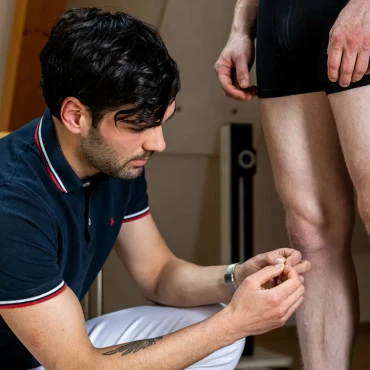Pelvic obliquity and leg length discrepancy - a complex static problem in which the orthopaedic surgeon must make a clear distinction
The static relationships and myofascial linkages in leg length discrepancy and pelvic obliquity can be extremely complex. It is important to differentiate strictly between a so-called anatomical leg length discrepancy, where the legs are of different lengths, and a functional leg length discrepancy, where the legs only appear to be of different lengths.
Anatomically different leg lengths can have very different causes: They can be caused by an injury to the growth plate in childhood, a childhood hip joint deformity (hip dysplasia), a leg axis misalignment or a foot problem, but also in adulthood after a bone fracture, osteoarthritis in the hip joint or knee joint and often after a hip prosthesis
implantation. This anatomical leg length difference inevitably leads to a pelvic obliquity and thus to a scoliotic malposition of the spine. In the medium and long term, even a few millimetres of leg length difference can lead to orthopaedic problems and back pain, for example.
On the other hand, there is pelvic obliquity, which is caused by a functional leg length discrepancy and can also have very different causes. A variety of functional dysfunctions can trigger a functional leg length discrepancy, ranging from a sacroiliac joint block (SIJ), a vertebral block, an atlas block or a bite dysfunction (CMD) as a descending chain to a tarsal block, e.g. after twisting the ankle joint, as an ascending chain.
What therapeutic approaches do we offer you in our orthopaedics and osteopathy practice?
To find out what type of leg length discrepancy you have, we offer you a thorough diagnosis with a detailed orthopaedic and osteopathic examination and treatment, supplemented by a 3D/4D spinal measurement and posture analysis.
If this reveals that you suffer from an anatomical leg length discrepancy and a pelvic misalignment as a result, the leg length must be anatomically corrected. For example, orthopaedic insoles made by orthopaedic shoe technicians can be used for this purpose, which we also adapt precisely to the optimum individual requirements with the aid of 3D/4D spinal column measurement. This anatomical alignment of leg lengths can harmonize pelvic obliquity as well as possible problems further up the spine, such as scoliotic misalignment, which can often lead to back pain or even neck pain.
In contrast, orthopaedists and osteopaths have to take a completely different approach to treating functional pelvic obliquity. The associated health problems, which often extend to knee pain and Achilles tendon problems (achillodynia), can only be tackled if the actual cause is precisely diagnosed and eliminated.
For example, it is often necessary to eliminate not only the existing blockage of the sacroiliac joint (SIJ) but also blockages in the overlying spinal sections and myofascial imbalances. In such a case, it would be fatal to work with insoles straight away, as the patient's problems would be "cemented" and subsequently exacerbated.
For the treatment of a functional pelvic obliquity and the resulting leg length discrepancy, this means that As your orthopaedic surgeon, I must take a very close look and intervene sensitively at the relevant points of the musculoskeletal system. All factors that contribute to symmetrical body statics, that are important in connection with scoliosis and that reduce or prevent muscular imbalances must be taken into account. The overriding goal must be to achieve the most balanced body statics and body symmetry possible. And this can ultimately also compensate for the difference in leg length.
As an orthopaedist and osteopath, this complex and cause-focused approach in our practice is particularly important to me for patients who suffer from both anatomical and functional leg length discrepancies. In these cases, the demands on the complexity of the treatment are usually even higher.


Book a consultation appointment now!
A quick, simple and easy way to your appointment.
Leg length discrepancy and pelvic obliquity can have far-reaching consequences if left untreated
If a leg length discrepancy or pelvic obliquity, whether functional or anatomical, persists over a long period of time, this can have significant consequences for the entire body statics. This can lead to the development of a scoliotic misalignment or scoliosis. This can lead to muscular imbalances with back pain, neck pain or headaches through to shoulder pain and discomfort in the arms. Furthermore, the leg axis or foot statics can change, resulting in knee pain, Achilles tendonitis (Achillodynia), heel pain (as with heel spurs), plantar fasciitis or metatarsalgia (foot pain).
The complexity outlined above makes it necessary for me as an orthopaedist and osteopath to first take a very close look at every patient in our practice in whom we detect a leg length discrepancy or pelvic misalignment and to differentiate clearly:
-
Are we dealing with an anatomical leg length discrepancy that subsequently causes pelvic obliquity? From here, the static difficulties and stresses can spread up the spine to the thoracic spine, the shoulder girdle or the cervical spine with an atlas blockage.
-
Or is the pelvic obliquity caused by a so-called functional leg length discrepancy? This is the case for most patients in our practice. In this case, the cause lies elsewhere. It can be a twisting of the pelvis, but it can also be caused by a blockage of the lumbar spine, a bite dysfunction (CMD) or a problem with the atlas vertebra.

